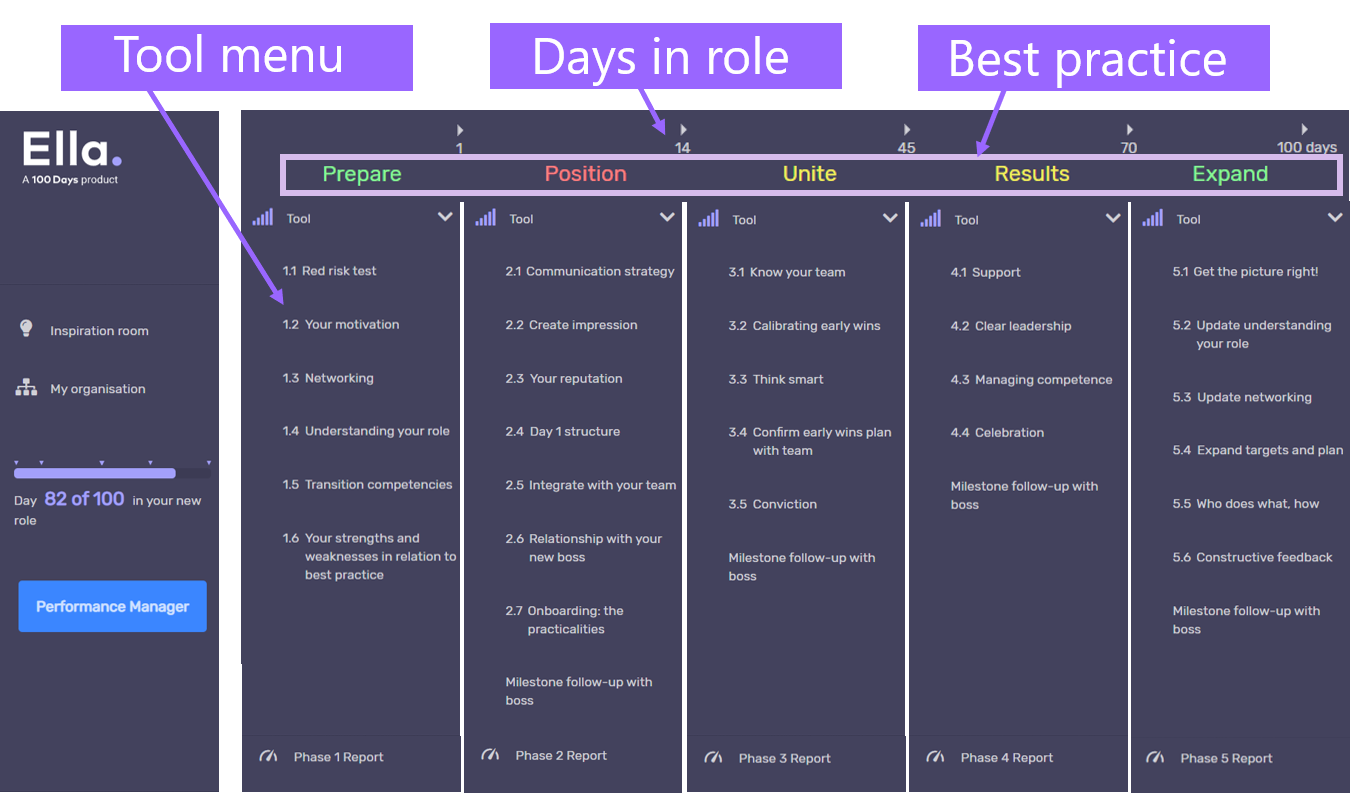
Hitting participants’ needs is one of the 3 main challenges (needs, transfer, measurement) to ensuring that leadership development works, as identified in How to make leadership development effective The accepted best practice approach of training needs analysis → identifying gaps → training gaps → measuring effect is ineffective. This article describes why needs analysis is so challenging and suggests 4 alternative ways to deal with participant needs.
There is no point in including topics that are not experienced as relevant by participants. They have to feel a real need to learn, either because the topic hits home personally or because they can see immediately how to apply what they learn in their own context, preferably to solve a pressing need.
Lack of complete relevance, or delay until the learning becomes relevant for a future need, kills the effect of any development programme.
Organisations have to work out how to meet participant needs in leadership development programmes. And it’s difficult.
Google searches about needs and training lead to recipes that look something like the model below:

The figure is a version of the best practice that learning and development professionals accept. Articles like this one, building off the received wisdom in all training and development textbooks, give practical advice about how to implement best practice. Business goals can be things like more innovation, better co-operation or more customer / service-user focus. These are broken down into competencies. Competencies relevant to particular roles are chosen, employees measured, gaps and needs identified, and training designed and run. The accepted best practice process is just as relevant for manager development as for general competence development for all employees.
The acceptance of best practice led, in the late 1980s, to HR functions building competence management systems. IT-systems were developed to manage all the competencies, roles, gap evaluations and learning activities. Individual managers and employees struggled to find the time to run both goal setting and competence development processes (the two halves of Performance Management). However, the understanding that competence was important + the desire to have structured, measurable systems means that everyone still follows the accepted best practice pretty faithfully.
The approach is cumbersome and most managers and employees see it as overly bureacratic. The quality in conversations about real needs is compromised. The link between training and need is too weak.
Indeed, this approach underestimates the complexity of identifying needs. Measuring gaps to expected performance on pre-defined competences is a gross oversimplification.
Learning is a process that starts with a need. Needs can be internal or external:
Internal and external needs work together. An external gap, for example impressing a boss, boosts the strength of the internal drivers like curiosity, the desire to achieve mastery and wanting recognition.

Change, as most of us conceive of it, doesn’t come without a gap. Rehabilitation for an alcoholic starts with “My name is Jane; I am an alcoholic”. In making such a statement publicly, Jane recognises the unacceptability of the status quo and the need to do something about it. She will now be open to learning new ways of mastering her challenges.
Recognising personal development needs is complicated. Self-respect, embarrassment, denial, and rationalisation all get in the way to a certain extent, for all of us, all the time. Not just for alcoholics.

We have multiple ongoing ‘conversations’ with ourselves and others about our learning and development needs. These conversations are influenced by a mixture of self-doubt and self-criticism on the one side, and pride and contentment on the other. And our views on ourselves can change from moment to moment.
These mechanisms are equally relevant for learning in the workplace as in all other parts of life.
In conversation with a recently retired General (ex-Head of the Army) the other day he said that admitting to weaknesses and vulnerabilities became more and more difficult through his career. Leaders build strength, convincing themselves that they are worthy to lead others. The higher they go, the more convincing to be done. The effort to do this takes space at the expense of the self-doubt and self-criticism that are necessary for the recognition of gaps in oneself.

This journey is, of course, individual. Some retain humility whilst others become self-righteous, denying their faults. But the process is the same for everyone. There is a clear tendency to become less humble as we climb the hierarchy.
Organisations are beset by defensive reasoning that makes recognising gaps difficult. Defensive reasoning becomes a part of the culture, reinforcing the difficulties employees and leaders have in recognising gaps.
One of the leading management scientists of the 20th century, Chris Argyris, made his name through discussions of defensive reasoning in organisations. His concept of double-loop learning, where reflective honesty and open information bypass organisational defences and lay a platform for deeper learning, is a cornerstone of the field of organisational learning.

Not many organisations manage to achieve double-loop learning. The classic example of failure is Kodak, with a fatal outcome. They stuck to physical film whilst digital technology wiped out their market. Management had a litany of ‘good’ reasons to stick to what they knew. Systemic racism in the Police in any country is another example, where admission of a need to change is very difficult. Again, defensive reasoning protects the status quo.
All organisations have their versions of defensive reasoning.
So, not only is accepted best practice ineffective, it grossly underestimates the difficulties involved in identifying needs.
Luckily, there are practical alternatives.
As described above, needs analysis is difficult and the systems developed to manage competence are complicated and bureaucratic.
The normal solution is to base leadership development programmes on generic frameworks. Business goals, like more innovation, are translated directly into models and frameworks for how to manage innovation. Training in these models is then rolled out. Participants become experts in the general principles of managing innovation.
Jumping from business goal to generic framework means that participant needs are generalised and assumed, not mapped and addressed.
This breaks the accepted best practice philosophy. Innovation isn’t broken into competencies and

mapped to roles. Managers are not evaluated. Gaps not defined. Without the baseline per manager it isn’t possible to measure effect per individual.
Given that accepted best practice is ineffective, discarding it in this way is a good thing.
Have a look at How to measure the impact of leadership development programmes if you are interested in alternative methods for measuring effect.
But how does the manager now transfer their understanding of general principles to the specifics of their work context?
Leadership developers work hard to make it easier to transfer learning from the generic to the specific. Practice sessions in a leadership development programme are normally based on real life cases that make the principles relevant. If the participants are lucky, they are called upon to use their learning immediately, perhaps in a project chosen as a ‘lab’ for their learning.

Irrespective of how the programme is designed, if it is based on generic concepts, the participant will struggle to transfer learning.
In section 2 above we described how difficult it is to identify and analyse needs because people are complicated. We can talk about needs analysis as if it is simple, but that doesn’t change human nature.
Needs analysis can be made simpler if the organisational culture is an enabler rather than a blocker. As an example, if an organisation is politicised, with leaders manipulating information and jockeying for position, the level of openness and trust is likely to be low. The motivation to admit fault, reveal vulnerability and discuss personal development will be limited. People will be too worried about how any admission of fault or vulnerability will be used against them.

There are 2 main approaches to managing culture: the direct and the indirect. The direct approach is to talk about it, developing values or principles and evaluating whether the organisation manages to live up to its aspirational statements. The indirect approach is simply to do things differently. These changes become habits and influence the organisation’s values indirectly. This is most easily seen with the introduction of a new leader. If they do things differently the culture changes by default, bit by bit.
The concept of the learning organisation is perhaps the most relevant source of inspiration in this area. The term was coined by Peter Senge and popularised in his book The Fifth Discipline in 1990.
Gestalt-based leadership developers get the participants to describe and focus on their needs by taking a completely different approach. They bring unproductive behaviour patterns to the surface by asking questions about how the pathway to achieving goals is broken.
The unproductive behaviour patterns are synonymous with what needs to be fixed. In the gestalt world they are called broken gestalts.
Fragments of both the problem and solution appear when participants talk about how things work in their context. The key to this approach is the skill of the facilitators. They have to get the ball rolling in the right way, build trust with the participants and delve deeper and deeper, step by step.
A successful gestalt-based Scandinavian leadership development company ran 3-day development processes based on one introductory question:
“Please give the feedback that is necessary for achieving X”.
where ‘X’ was an important programme being run in the organisation. There was no other pre-determined structure.
The facilitators helped the group explore the issues that stood in the way of success, developing the solid floor of trust necessary for the participants both to talk more honestly and to come up with new ideas.
The approach is very process oriented. It is not based on teaching frameworks, though the facilitators point to frameworks spontaneously to help explain things that happen during the process. It is difficult to describe beforehand what will happen as the value emerges during the process. It is therefore an approach that is difficult for organisations to buy. It can also be a personally challenging process for participants.
When run well, it works well. The factors that limit management’s ability to fulfil an organisation’s potential are aired and fixed. That creates real value and the participants go through a powerful learning experience.
The digitalisation of leadership development has led to a rapid increase in choice. Some even imagine that a good google search could replace all structured leadership development one day. (Have a look at The Google method of effective leadership development for more). Individual leaders will simply put together their own set of learning activities, mixing free and purchased material.

When the individual finds their own support and development activities online, the choices are needs-driven. No needs analysis is needed. The need appears and the matching solution is found instantaneously.
We believe that there will still be a need for structured programmes and want to provide an example where the participant chooses from a menu of tools that are relevant to their situation.
Leaders face real challenges when starting in a new role, whether as the product of an external or internal move. A lot can change with a new boss, colleagues, team members, customers, service users, goals, tasks, work processes, IT-systems, location, culture etc. When a lot changes, a lot can go wrong.
When research tells us that up to 40% fail, it is clear that a programme that boosts the success rate would be helpful.
ELLA, the digital coach supporting success in 100 days, helps the manager follow best practice and offers a menu of tools per step.
The point here is that the user is expected to adapt the programme to suit their specific needs.

There are more tools than most managers will want to use, but that is the nature of a menu. You take what you want. You don’t eat all the main courses on offer.
The tools are relevant to the situation. For example, all managers benefit from systematic preparation before they start in a new role. As part of preparing, all managers need to understand their role, targets and context (tool 1.4). They are also dependent on a network as they work with and through others to create results (tool 1.3). Some may be interested in their chances of success (1.1) and whether they have the competencies needed (1.5 and 1.6). Others may be interested to revisit their motivation for the job (1.2).
The point is that they choose the tools most relevant for them, jumping over a needs analysis. They also jump over the transfer problem as the tools are directly linked to their work. They are doing their work in ELLA and learning as they go.
We believe the textbooks are wrong to focus so much on needs analysis. This focus has produced cumbersome, bureaucratic competence management systems that provide limited value, especially to management development. We believe it is more effective to choose different ways to match participant needs with training content. Digitalisation offers many opportunities (see Competitive trends in the leadership development industry for more), as do cultural and gestalt solutions, as well as the normal approach of teaching generic concepts.
If you want to understand more about how a digitally supported approach to helping leaders succeed in 100 days can benefit your organisation, please download our e-book!
Organisational psychologist with an MBA. Broad top management experience spanning many industries, functions and countries, including 10 years with corporate responsibility for HR. Extensive experience as consultant in private, public and voluntary sectors. A number of board positions in the education and culture sectors. Started career as counsellor for drug and alcohol abusers.
We write professional blogs worth a read.
Follow the blog for a sneak peek of the future!
* By subscribing to our newsletter, you agree to receive digital communications. You may withdraw this consent at any time.

May 10, 2021 - Richard Taylor C. Psychol., MBA
Leaders need help to succeed in a new role when so much changes, and expectations are so high. Springboarding..

Nov 01, 2020 - Richard Taylor C. Psychol., MBA
We all use google searches to find answers to our questions. We often look at the videos google suggests for..

Nov 01, 2020 - Richard Taylor C. Psychol., MBA
Many are sceptical to the return on the investment made in leadership development. A promising new approach..